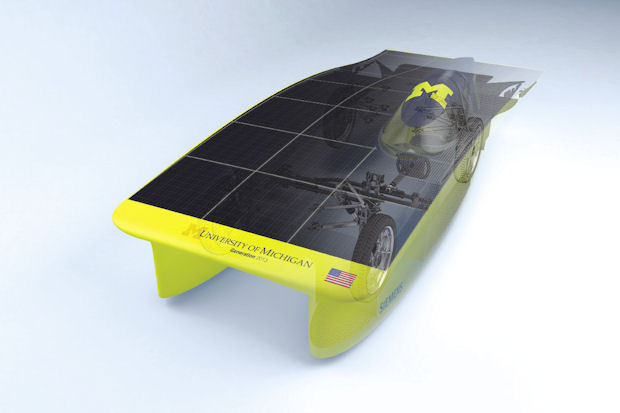
Quantum, the 11th solar car designed and built by University of Michigan students, took first prize in the American Solar Challenge in July 2014.
September 1, 2014
 Quantum, the 11th solar car designed and built by University of Michigan students, took first prize in the American Solar Challenge in July 2014.
Quantum, the 11th solar car designed and built by University of Michigan students, took first prize in the American Solar Challenge in July 2014.Quantum is the 11th car built by the University of Michigan Solar Car Team (UMSCT). It weighs 320 lbs., with an anticipated top speed of 105 mph. The vehicle is 200 lbs. lighter and 30% more aerodynamic than its predecessor Infinium, according to the UMSCT’s online records. That dramatic design improvement gave the team an edge in the American Solar Challenge. Plowing through roughly 1,720 miles across seven states, Quantum clocked in at 41:27 min and took first place—beating runner-ups from the University of Minnesota (45:19 min) and Iowa State University (50:18 min).
Because they were given access to a rich portfolio of advanced manufacturing software products from their sponsor, Siemens PLM Software, the UMSCT came to understand the importance of system-level thinking.
The Vehicle as a Whole
In a video interview with Siemens, Arnold Kadiu, the team’s engineering manager, sums up the wisdom that drove them toward system-level design: “It’s easy to design just a steering wheel that works really well, an isolated suspension system that works really well, or a braking system that works really well by itself. Bringing it all together is really the hard part.”
This strategy led to switching all design works into a single modeling environment, NX 9. Pavan Naik, the team’s senior business development manager, says, “As we began to prepare to compete with the best teams in the world in 2013, we knew we needed more comprehensive PLM software technology. The breadth of functionality for design, simulation, and aerodynamic surface modeling in NX are far beyond anything we have used in the past.”
Connor O’Brien, the team’s race manager, agrees: “Without the software, I do not see how we could have built the car.”
In addition to NX software for mechanical modeling and simulation, the team also had the chance to explore Siemens’ Teamcenter (for data and project management), Fibersim (for material behavior simulation), and LMS (for test and simulation data). Naik says the team might have saved about two months from the design cycle if they had begun using Teamcenter earlier.
UMSCT also used NX’s Tecnomatix software to create Bobble Jack, a digital avatar that helped them analyze the driver’s comfort and ergonomics. When the team wanted to study the driver’s head clearance, tight deadlines prompted an ingenious shortcut. Instead of modeling a helmet, they resized Jack’s head to match the volume of a driver wearing a helmet, resulting in an oversized head. And that’s how Bobble Jack got his name.
The Carbon Fiber Advantage
The vehicle is powered solely by a lithium ion battery, a limited power source. So the best possible strategy to win the race is to improve the vehicle’s aerodynamics.
“By using high-modulus carbon fiber, we were able to design thinner structures and maintain the car’s low aerodynamic design,” Naik says. In future incarnations, he adds, the team plans to use Siemens’ Fibersim software.
The team’s victory in the American Solar Challenge may be the prelude to something else. In a press release by Siemens, Naik reveals he and his colleagues are setting their sights on the World Solar Challenge 2015, set to take place in the Australian outback.
When The New York Times asked the team to explain the vehicle’s name, project manager Rachel Kramer notes that “Quantum is appropriate because it makes you think of something very small and precise, and that’s what we had to do to be the best in the world” (Source: “Taking Off the Pounds to Chase a Sun-Powered Victory,” NYT, April 12, 2014). One might also recognize that the last two letters in its name happen to stand for the University of Michigan—and for that matter, its color scheme helps it to “Go Blue.”
For more, read about two other solar car teams in “Racing Against the Sun.”
More Info
Subscribe to our FREE magazine, FREE email newsletters or both!
About the Author
Kenneth Wong is Digital Engineering’s resident blogger and senior editor. Email him at [email protected] or share your thoughts on this article at digitaleng.news/facebook.
Follow DE





